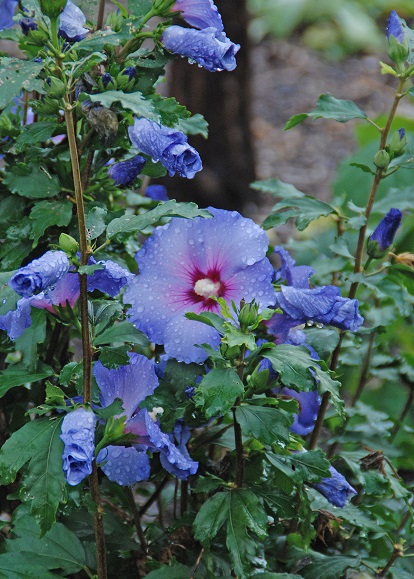Create a colorful year-round garden filled with flowers, greenery, colorful fruit, fall color, winter interest and a few surprises. Consider seasonal interest when planning a new garden or landscape. Adding a few key plants to existing gardens can help boost your landscape’s seasonal appeal.

Include a variety of plants with multiple seasons of interest as well as bird and pollinator appeal. You will look forward to the change of seasons as your landscape transforms throughout the year.
Use trees and shrubs to provide the framework and longevity in your landscape. Serviceberries, crabapples, dogwoods, and many others have flowers and fruit, along with pollinator, and bird appeal. They can also add winter interest with their bark or form. Look for those with colorful exfoliating bark like paperbark maple, heptacodium, and river birch for a beautiful statement in the winter garden.
Include a few summer blooming shrubs like St John’s wort, buttonbush, panicle hydrangeas and Rose of Sharon. They add an unexpected fresh look to your summer landscape.
Perennials combine nicely with trees, shrubs, and annuals, adding seasons of color and texture. Include those that also attract songbirds, bees, and butterflies by creating a beautiful habitat. Blue star (Amsonia), Siberian iris, sedum, Rudbeckia, coneflower, and grasses are just a few that can brighten any garden with several seasons of color, provide homes for beneficial insects and food for the birds.
End the season with fall bloomers like goldenrod, asters, and hardy mums. These provide food for late season pollinators. Leave healthy plants stand, providing homes for many beneficial insects, winter interest in the garden, and food for the songbirds.
Use annuals to fill any voids, add season long color and yearly changes in the landscape. Containers on steps, decks and patios help bring the garden to your front and back door.
Include spring flowering bulbs like tulips, daffodils and hyacinths planted in fall for a colorful welcome to spring. These and many of the earliest bloomers like winter aconites, grape hyacinths, and crocus provide needed nectar for early season pollinators.
Evergreens are always a welcome addition to any landscape. They provide shelter for the birds and year-round greenery. Use taller evergreens for screening bad views, buffering traffic and other noises, or creating privacy. Use evergreens with interesting form and texture to create a focal point in a garden bed or landscape. Combine them with perennials and flowering shrubs for added seasonal interest.
Continue to gather ideas with visits to public gardens and partaking in garden tours. Be sure to take notes and pictures that you can reference later. Creating a year-round landscape is an ongoing process that is part of the fun and adventure of gardening.
Melinda Myers has written more than 20 gardening books, including Small Space Gardening. She hosts the “How to Grow Anything” DVD series and the Melinda’s Garden Moment TV & radio segments. Her website is MelindaMyers.com.
Related Articles & Free Email Newsletter
10 Great Plants for an All Season Perennial Flower Garden for Spring
Creating a Backyard Bird Sanctuary
Designing the Perfect All Season Perennial Flower Garden for Summer
Subscribe to our Free Email Newsletter
Photo courtesy of Melinda Myers.




Comment here